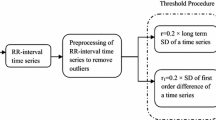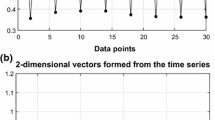Abstract
Complexity of heartbeat interval series is typically measured by entropy. Recent studies have found that sample entropy (SampEn) or fuzzy entropy (FuzzyEn) quantifies essentially the randomness, which may not be uniformly identical to complexity. Additionally, these entropy measures are heavily dependent on the predetermined parameters and confined to data length. Aiming at improving the robustness of complexity assessment for short-term RR interval series, this study developed a novel measure—distribution entropy (DistEn). The DistEn took full advantage of the inherent information underlying the vector-to-vector distances in the state space by probability density estimation. Performances of DistEn were examined by theoretical data and experimental short-term RR interval series. Results showed that DistEn correctly ranked the complexity of simulated chaotic series and Gaussian noise series. The DistEn had relatively lower sensitivity to the predetermined parameters and showed stability even for quantifying the complexity of extremely short series. Analysis further showed that the DistEn indicated the loss of complexity in both healthy aging and heart failure patients (both p < 0.01), whereas neither the SampEn nor the FuzzyEn achieved comparable results (all p ≥ 0.05). This study suggested that the DistEn would be a promising measure for prompt clinical examination of cardiovascular function.






Similar content being viewed by others
References
Amoud H, Snoussi H, Hewson D, Doussot M, Duchene J (2007) Intrinsic mode entropy for nonlinear discriminant analysis. IEEE Signal Process Lett 14(5):297–300
Bandt C, Pompe B (2002) Permutation entropy: a natural complexity measure for time series. Phys Rev Lett 88(17):174102
Bolea J, Laguna P, Remartínez JM, Rovira E, Navarro A, Bailón R (2014) Methodological framework for estimating the correlation dimension in HRV signals. Comput Math Methods Med 2014:1–11
Castiglioni P, Di Rienzo M (2008) How the threshold r influences approximate entropy analysis of heart-rate variability. In: Computers in Cardiology, Bologna, Italy, pp 561–564
Chen W, Zhuang J, Yu W, Wang Z (2009) Measuring complexity using FuzzyEn, ApEn, and SampEn. Med Eng Phys 31(1):61–68
Chon K, Scully CG, Lu S (2009) Approximate entropy for all signals. IEEE Eng Med Biol Mag 28(6):18–23
Clifford GD, Moody GB (2012) Signal quality in cardiorespiratory monitoring. Physiol Meas 33(9):E01
Costa M, Goldberger AL, Peng CK (2002) Multiscale entropy analysis of complex physiologic time series. Phys Rev Lett 89(6):068102
Costa M, Goldberger AL, Peng CK (2005) Multiscale entropy analysis of biological signals. Phys Rev E 71(2):021906
Goldberger AL (1996) Non-linear dynamics for clinicians: chaos theory, fractals, and complexity at the bedside. Lancet 347(9011):1312–1314
Goldberger AL, Amaral LAN, Glass L, Hausdorff JM, Ivanov PC, Mark RG, Mietus JE, Moody GB, Peng C-K, Stanley HE (2000) PhysioBank, PhysioToolkit, and PhysioNet: components of a new research resource for complex physiologic signals. Circulation 101(23):e215–e220
Hu M, Liang H (2012) Adaptive multiscale entropy analysis of multivariate neural data. IEEE Trans Biomed Eng 59(1):12–15
Iyengar N, Peng CK, Morin R, Goldberger AL, Lipsitz LA (1996) Age-related alterations in the fractal scaling of cardiac interbeat interval dynamics. Am J Physiol 271(4):R1078–R1084
Lake DE, Moorman JR (2011) Accurate estimation of entropy in very short physiological time series: the problem of atrial fibrillation detection in implanted ventricular devices. Am J Physiol Heart Circ Physiol 300(1):H319–H325
Li P, Liu C, Wang X, Li B, Che W, Liu C (2012) Cross-sample entropy and cross-fuzzy entropy for testing pattern synchrony: how results vary with different threshold value r. In: World Congress on Medical Physics and Biomedical Engineering, Beijing, China, pp 485–488
Li P, Liu C, Wang X, Li L, Yang L, Chen Y, Liu C (2013) Testing pattern synchronization in coupled systems through different entropy-based measures. Med Biol Eng Comput 51(5):581–591
Li P, Liu C, Wang X, Zheng D, Li Y, Liu C (2014) A low-complexity data-adaptive approach for premature ventricular contraction recognition. Signal Image Video Process 8(1):111–120
Lipsitz La GAL (1992) Loss of complexity and aging: potential applications of fractals and chaos theory to senescence. JAMA 267(13):1806–1809
Liu C, Liu C, Shao P, Li L, Sun X, Wang X, Liu F (2011) Comparison of different threshold values r for approximate entropy: application to investigate the heart rate variability between heart failure and healthy control groups. Physiol Meas 32(2):167–180
Liu C, Li L, Zhao L, Zheng D, Li P, Liu C (2012) A combination method of improved impulse rejection filter and template matching for identification of anomalous intervals in RR sequences. J Med Biol Eng 32(4):245–249
Lu S, Chen X, Kanters JK, Solomon IC, Chon KH (2008) Automatic selection of the threshold value r for approximate entropy. IEEE Trans Biomed Eng 55(8):1966–1972
Molina-Pico A, Cuesta-Frau D, Aboy M, Crespo C, Miro-Martinez P, Oltra-Crespo S (2011) Comparative study of approximate entropy and sample entropy robustness to spikes. Artif Intell Med 53(2):97–106
Nikita KS, Lin JC, Fotiadis DI, Arredondo MT (2012) Editorial: special issue on mobile and wireless technologies for healthcare delivery. IEEE Trans Biomed Eng 59(11):3083–3089
Nikulin VV, Brismar T (2004) Comment on ‘multiscale entropy analysis of complex physiologic time series’. Phys Rev Lett 92(8):089803
Pincus SM (1991) Approximate entropy as a measure of system complexity. Proc Natl Acad Sci USA 88(6):2297–2301
Pincus S, Singer BH (1996) Randomness and degrees of irregularity. Proc Natl Acad Sci USA 93(5):2083–2088
Poon CS, Merrill CK (1997) Decrease of cardiac chaos in congestive heart failure. Nature 389(6650):492–495
Porta A, Gnecchi-Ruscone T, Tobaldini E, Guzzetti S, Furlan R, Montano N (2007) Progressive decrease of heart period variability entropy-based complexity during graded head-up tilt. J App Physiol 103(4):1143–1149
Porta A, Castiglioni P, Bari V, Bassani T, Marchi A, Cividjian A, Quintin L, Rienzo MD (2013) K-nearest-neighbor conditional entropy approach for the assessment of the short-term complexity of cardiovascular control. Physiol Meas 34(1):17
Richman JS, Moorman JR (2000) Physiological time-series analysis using approximate entropy and sample entropy. Am J Physiol Heart Circ Physiol 278(6):H2039–H2049
Schmitt DT, Ivanov P (2007) Fractal scale-invariant and nonlinear properties of cardiac dynamics remain stable with advanced age: a new mechanistic picture of cardiac control in healthy elderly. Am J Physiol Regul Integr Comp Physiol 293(5):R1923–R1937
Schmitt DT, Stein PK, Ivanov P (2009) Stratification pattern of static and scale-invariant dynamic measures of heartbeat fluctuations across sleep stages in young and elderly. IEEE Trans Biomed Eng 56(5):1564–1573
Tarvainen MP, Ranta-Aho PO, Karjalainen PA (2002) An advanced detrending method with application to HRV analysis. IEEE Trans Biomed Eng 49(2):172–175
Theiler J, Eubank S, Longtin A, Galdrikian B, Doyne Farmer J (1992) Testing for nonlinearity in time series: the method of surrogate data. Physica D 58(1):77–94
Thuraisingham RA, Gottwald GA (2006) On multiscale entropy analysis for physiological data. Phys A 366:323–332
Valencia JF, Porta A, Vallverdu M, Claria F, Baranowski R, Orlowska-Baranowska E, Caminal P (2009) Refined multiscale entropy: application to 24-h Holter recordings of heart period variability in healthy and aortic stenosis subjects. IEEE Trans Biomed Eng 56(9):2202–2213
Voss A, Heitmann A, Schroeder R, Peters A, Perz S (2012) Short-term heart rate variability–age dependence in healthy subjects. Physiol Meas 33(8):1289–1311
Wagner CD, Persson PB (1998) Chaos in the cardiovascular system: an update. Cardiovasc Res 40(2):257–264
Xie H-B, He W-X, Liu H (2008) Measuring time series regularity using nonlinear similarity-based sample entropy. Phys Lett A 372(48):7140–7146
Yentes J, Hunt N, Schmid K, Kaipust J, McGrath D, Stergiou N (2013) The appropriate use of approximate entropy and sample entropy with short data sets. Ann Biomed Eng 41(2):349–365
Acknowledgments
We gratefully acknowledge support from the National Natural Science Foundation of China (61471223), the China Postdoctoral Science Foundation (2014M561933), and the Young Scientists Fund of the National Natural Science Foundation of China (61201049, 31200744).
Author information
Authors and Affiliations
Corresponding authors
Rights and permissions
About this article
Cite this article
Li, P., Liu, C., Li, K. et al. Assessing the complexity of short-term heartbeat interval series by distribution entropy. Med Biol Eng Comput 53, 77–87 (2015). https://doi.org/10.1007/s11517-014-1216-0
Received:
Accepted:
Published:
Issue Date:
DOI: https://doi.org/10.1007/s11517-014-1216-0




